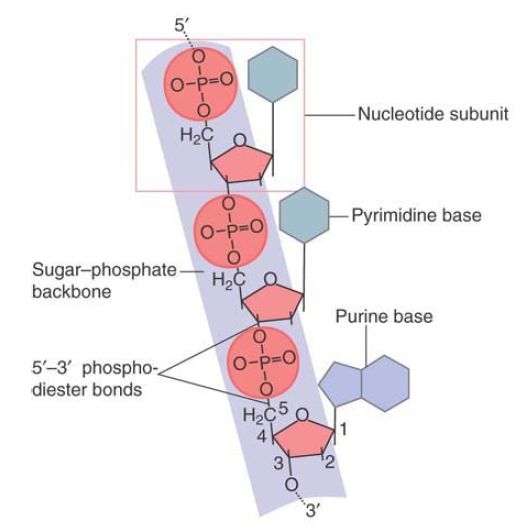


 النبات
النبات
 الحيوان
الحيوان
 الأحياء المجهرية
الأحياء المجهرية
 علم الأمراض
علم الأمراض
 التقانة الإحيائية
التقانة الإحيائية
 التقنية الحيوية المكروبية
التقنية الحيوية المكروبية
 التقنية الحياتية النانوية
التقنية الحياتية النانوية
 علم الأجنة
علم الأجنة
 الأحياء الجزيئي
الأحياء الجزيئي
 علم وظائف الأعضاء
علم وظائف الأعضاء
 الغدد
الغدد
 المضادات الحيوية
المضادات الحيوية| Polynucleotide Chains Have Nitrogenous Bases Linked to a Sugar–Phosphate Backbone |
|
|
|
Read More
Date: 28-11-2015
Date: 22-3-2021
Date: 28-5-2021
|
Polynucleotide Chains Have Nitrogenous Bases Linked to a Sugar–Phosphate Backbone
KEY CONCEPTS
-A nucleoside consists of a purine or pyrimidine base linked to the 1′ carbon of a pentose sugar.
-The difference between DNA and RNA is in the group at the 2′ position of the sugar. DNA has a deoxyribose sugar (2′–H); RNA has a ribose sugar (2′–OH).
- A nucleotide consists of a nucleoside linked to a phosphate group on either the 5′ or 3′ carbon of the (deoxy)ribose.
- Successive (deoxy)ribose residues of a polynucleotide chain are joined by a phosphate group between the 3′ carbon of one sugar and the 5′ carbon of the next sugar.
- One end of the chain (conventionally written on the left) has a free 5′ end and the other end of the chain has a free 3′ end.
- DNA contains the four bases adenine, guanine, cytosine, and thymine; RNA has uracil instead of thymine.
The basic building block of nucleic acids (DNA and RNA) is the nucleotide, which has three components:
-A nitrogenous base
-A sugar
-One or more phosphates
The nitrogenous base is a purine or pyrimidine ring. The base is linked to the 1′ (“one prime”) carbon on a pentose sugar by a glycosidic bond from the N of pyrimidines or the N of purines. The pentose sugar linked to a nitrogenous base is called a nucleoside.
To avoid ambiguity between the numbering systems of the heterocyclic rings and the sugar, positions on the pentose are given a prime (′).
Nucleic acids are named for the type of sugar: DNA has 2′–deoxyribose, whereas RNA has ribose. The difference is that the sugar in RNA has a hydroxyl (–OH) group on the 2′ carbon of the pentose ring. The sugar can be linked by its 5′ or 3′ carbon to a phosphate group. A nucleoside linked to a phosphate at the 5′ carbon is a nucleotide.
A polynucleotide is a long chain of nucleotides. FIGURE 1 shows that the backbone of the polynucleotide chain consists of an alternating series of pentose (sugar) and phosphate residues. The chain is formed by linking the 5′ carbon of one pentose ring to the 3′ carbon of the next pentose ring via a phosphate group; thus the sugar–phosphate backbone is said to consist of 5′–3′ phosphodiester linkages. Specifically, the 3′ carbon of one pentose is bonded to one oxygen of the phosphate, whereas the 5′ carbon of the other pentose is bonded to the opposite oxygen of the phosphate. The nitrogenous bases “stick out” from the backbone.

FIGURE 1. A polynucleotide chain consists of a series of 5′–3′ sugar–phosphate links that form a backbone from which the bases protrude.
Each nucleic acid contains four types of nitrogenous bases. The same two purines, adenine (A) and guanine (G), are present in both DNA and RNA. The two pyrimidines in DNA are cytosine (C) and thymine (T); in RNA, uracil (U) is found instead of thymine. The only structural difference between uracil and thymine is the presence of a methyl group at position C .
The terminal nucleotide at one end of the chain has a free 5′ phosphate group, whereas the terminal nucleotide at the other end has a free 3′ hydroxyl group. It is conventional to write nucleic acid sequences in the 5′ to 3′ direction—that is, from the 5′ terminus at the left to the 3′ terminus at the right.



|
|
|
|
تفوقت في الاختبار على الجميع.. فاكهة "خارقة" في عالم التغذية
|
|
|
|
|
|
|
أمين عام أوبك: النفط الخام والغاز الطبيعي "هبة من الله"
|
|
|
|
|
|
|
قسم شؤون المعارف ينظم دورة عن آليات عمل الفهارس الفنية للموسوعات والكتب لملاكاته
|
|
|